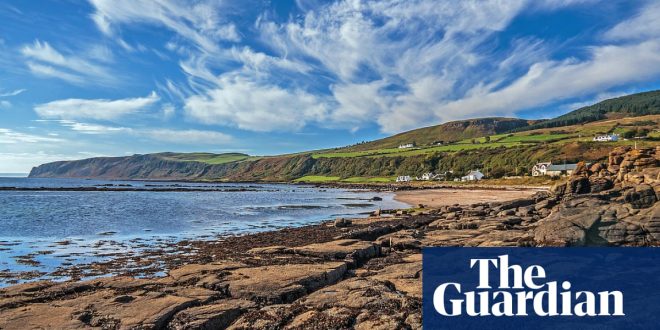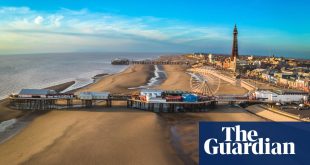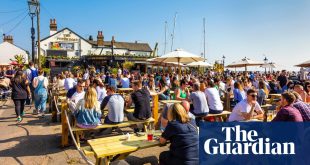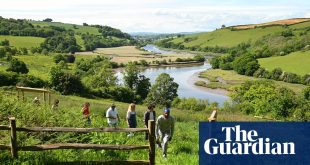As we climb up to Eas Mor waterfall in the south of the island of Arran, I pause to read the words carved into a fallen tree across our path: “Bow your head for you enter sacred and magical lands.” There’s a lot about Arran that is sacred and magical. Growing up in Glasgow, I went to the island several times as a child, played mini golf at Brodick and spent hours combing beaches for perfectly smooth, multicoloured stones. My husband’s family used to decamp from London for long summer holidays too: stories of three-year-olds trudging up Goatfell – the island’s tallest peak at 874 metres – are the stuff of family fable.
We have two children of our own now – Henry, eight, and Isobel, five – and we brought them back to this beautiful Firth of Clyde island in May half-term. Arran is often dubbed “Scotland in miniature”, but that is especially true and pertinent for families. You can be there in about two hours from Glasgow, and the island’s main road is a continuous 55-mile loop around its coast, taking in wild beaches, misty castles, whisky distilleries and looming granite mountains.
Eas Mor is the ideal family walk to ease in little legs: steep enough through the wooded valley to feel vigorous, but short enough to beat the onset of moaning, and the Forest of the Falls Cafe at the end for bribes of homemade cake.
The waterfall, a long plume that plunges into a ravine, is dramatic, but the real magic has been created by Albert Holmes of the Eas Mor Ecology project, who turns felled trees into intricate wooden artworks, including kelpies and fairies hidden among vines and wild, throne-like benches.
In one clearing, there’s a turf-roofed log cabin now called The Library, where we find Albert replenishing the stacks of paper and colouring pencils inside. On every inch of the walls and ceiling, visitors have pinned their drawings and words: sketches of the view out to the dome-like island of Ailsa Craig alongside poems for peace.
Afterwards, we head to the beach below at Kildonan, in search of more secrets. Arran is in the process of becoming a Unesco global geopark: the Highland boundary fault line cuts through the island’s middle, and in 1787 a spot near Lochranza in the north was the site of one of geologist James Hutton’s first “unconformities”, proving the immense age of the Earth.
Here at Kildonan, hidden in the rocks, is a footprint left by a giant reptile about 240m years ago. We study outlines on the shore at low tide, prodding barnacles with our hiking boots until we practically step in it, its five toes distinctive among the other ripples in the rock (the creature’s name is chirotherium, meaning “hand beast”).
The next day we take a trip on the Lady May from the pier at Lamlash, sliding out past paddleboarding families near the shore to cruise around the bay and sail alongside Holy Isle. “Look, that gannet is about to go for his lunch,” says Lamlash Cruises’ guide Tim Harvey, pointing to the dive-bombing bird as Henry and Isobel take turns with a huge pair of binoculars. “They can hit the water at up to 60 miles an hour.”
There’s a gannet colony on Ailsa Craig, he tells us, as we catch a glimpse of the mighty rock in the distance, and the uninhabited island’s ultra-dense granite is still quarried (outside of seabird breeding season) to make most of the world’s curling stones.
Arran is not short of notable stones. Last year a rare complete Neolithic cursus (ceremonial enclosure) about 1,100 metres across was discovered at Drumadoon in the south-west. We’re staying near there in an old farmhouse. From our front door it’s a short walk through fields of bleating lambs to the stone circles at Machrie Moor. There are the remains of six circles, thought to have been erected around 2000BC, and all sorts of mythical stories to tell the kids – that Fingal the giant used the stone with a hole in it to tether his dogs while he ate; that fairies once sat at the top of Durra-na-each flicking pebbles down the moor that grew into the stones – as they whirl around in the faint drizzle beneath megaliths that stand up to five metres tall.
My children’s transformation from urban kids to mountain goats is complete with a serious hike up and over the saddle at Glen Sannox. They trot along as the trail winds through a carpet of ferns and later – as I cling with fear when the wind whips up in gusts – the pair of them scramble up the rocky bits, laughing. At the top we huddle behind a boulder, munching crisps, recovering before the long, gentle walk down through Glen Rosa. In this deep, green valley carved by a glacier hundreds of metres thick, they hop across giant stepping stones in the burn and dodge fat, furry caterpillars on the path.
We’ve walked up eight miles’ worth of appetite, but from there it’s not far to the seaside village of Corrie, where the picnic benches outside Mara Fish Bar & Deli are packed: hikers and other hungry holidaymakers are tucking into spiced whiting tacos and hand-dived scallop gratin (mains from £9.50). Afterwards, we stop at Cladach Beach House, a beach bar on the edge of Brodick, where my husband and I order raspberry Tom Collins made with Arran gin (cocktails from £7.50) while the children slurp apple juice and play football on the sand with new friends. Just a little further down the road, the French Fox serves croque-monsieurs and poulet breton (with cream and cider) from its turquoise vintage Peugeot van. The Parlour opposite Brodick beach does sourdough pizzas and Arran Dairy ice-cream.
By our last morning the sun is feeling even bolder and we buy supplies for a beach picnic from Blackwater Bakehouse, on a tiny lane behind the Kinloch Hotel. As Henry swithers over a plump pain au chocolat or a gloriously sticky cinnamon knot from the honesty “breadshed”, I chat to owner George Grassie, who it turns out used to live a few roads from where we now do in south London. He grew up in Arran and moved back so his children could have the kind of free-range childhood he enjoyed on the island. Down on wide, sandy Blackwater beach, I can see his point. A group of young riders on horseback trot past along the shore (nearby Cairnhouse Stables organises pony treks) and my kids sprint in and out of the small waves, giddy and shrieking. They strip down to their pants and jump off rocks into the cold water, search shallow pools for little beasties and skim stones across the sea. Sacred and magical indeed.
CalMac sails to Arran from Ardrossan (55 minutes) and Troon (1 hour 20 minutes) from £9.20 return as a foot passenger; trains from Glasgow Central connect with the ferry times. The writer and her family stayed at Balnagore Farm near Machrie (from £650 a week, sleeps 11)
 Top Naija News – Nigeria News, Nigerian News & Top Stories Top Naija News – Nigerian Newspapers, Nigerian News. topnaijanews is a daily Nigerian newspaper covering Latest News, Breaking News, Entertainment, Sports, Lifestyle and Politics.
Top Naija News – Nigeria News, Nigerian News & Top Stories Top Naija News – Nigerian Newspapers, Nigerian News. topnaijanews is a daily Nigerian newspaper covering Latest News, Breaking News, Entertainment, Sports, Lifestyle and Politics.




